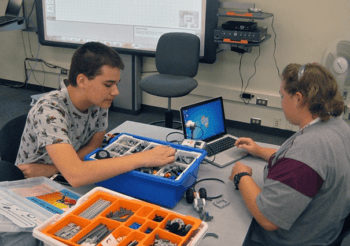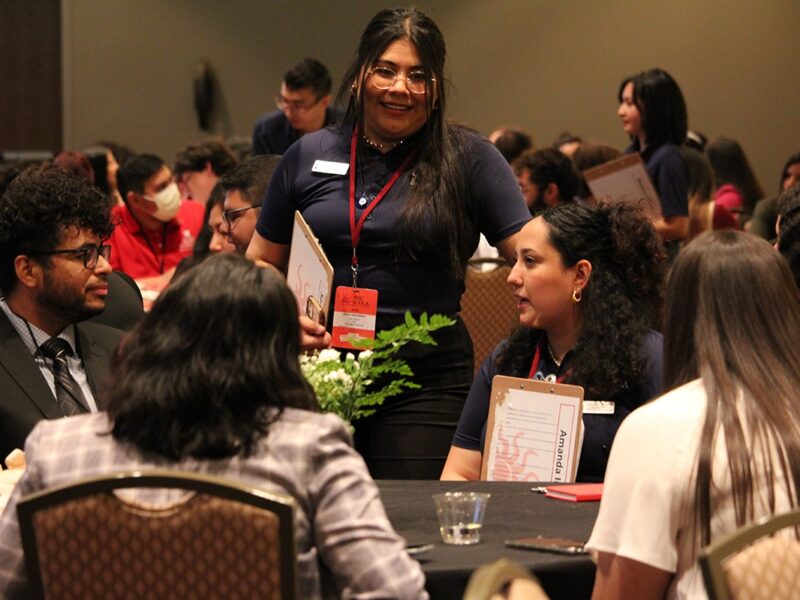Increasing Diversity And Leading With STEM Education

Achieving diversity and equity within the science, technology, engineering and math (STEM) fields is an overall goal for universities and researchers working in these areas, including the College of Education and Human Development at Texas A&M University. And building the network to diversify STEM education should begin before students ever enroll in college.
Robert Capraro, Aggie STEM co-director and mathematics education professor in the department of Teaching, Learning and Culture, cites the importance of first attracting a diverse group of students in middle and high school to begin thinking about STEM coursework. His unique multi-disciplinary approach involves engaging students, parents, teachers and college faculty working together to significantly enhance diversity within STEM.

He has found that the best way to introduce diversity and equity in STEM education is to acknowledge students who may not readily stand out on paper as high-achievers. “It’s the kids who are on the borderline that often get overlooked, and may not choose classes in a STEM-related area because their potential was not recognized,” said Capraro. “They may take classes less challenging or not as rewarding as STEM.”
Capraro is also principal investigator and co-director for the STEM Collaborative for Teacher Professional Learning and leads the Aggie STEM Summer Camp for students in high-need and urban middle and high schools. Both serve to help students and K-12 educators make the transition into an integrative STEM Project-Based Learning approach.
During the 2013 STEM Summer Camp, held at Texas A&M, students learned about solar energy collection and robotics, and participated in other reading and writing techniques used in the classroom. Outside the classroom, they spent time with College of Education and Human Development undergraduates majoring in STEM-related fields to learn more about college from a student’s perspective.
Teachers were also invited to attend a professional development boot camp to learn how to prepare STEM Project-Based Learning lessons that incorporate integrative learning – mainly how their subject area of teaching works together within the STEM field. The teachers also engaged in activities with college STEM faculty and observed best practices to increase student involvement in the classroom.
“Part of the overall experience that benefits teachers at the summer camp is they get to see that all kids can learn from a STEM Project-Based education. It’s amazing how human potential works. People can be really talented in something, but until somebody recognizes and pulls that out of them, they won’t necessarily display those talents and abilities,” said Capraro.
The third component to introducing more diversity into the STEM pipeline is working with parents. Just like students, getting parents to engage means respecting their busy work schedules and providing opportunities for them to meet other parents from similar backgrounds. Finding ways to communicate with parents helps them make better decisions about their children attending a college far from home or in a different environment to which they are accustomed.
“In our parent workshops, we try to make sure we have a few well-seasoned parents who are able to advocate for the summer camp and let their children attend Texas A&M. That’s a very important thing, because families might select a college that is closer to home, but may not be the best at producing a career their child wants to pursue,” said Capraro.
Just as the right support system is critical in making a successful transition to college for any student, the relationships formed at the STEM Summer Camp are pivotal for students from minority backgrounds, low-income families or first-generation college attendees. These relationships help ease their transition into college life. Lack of exposure and representation, combined with a small percentage of other diverse students in classrooms, have been cited in university and industry studies as reasons why some students don’t continue with STEM-related courses.
The recent two-year $764,000 grant to establish the STEM Collaborative for Teacher Professional Learning allows the College of Education and Human Development, College of Science and the Dwight Look College of Engineering at Texas A&M University to collaborate on increasing STEM teacher quality and preparation. Through their research, the collaborative wants to increase STEM teacher development and STEM student achievement across a broader spectrum.
“Research indicates that an integrated program works best and essentially allows us to work with more groups and build in educational equity for everyone in the group regardless of gender or race,” said Capraro.
The collaborative will employ an integrated model that consists of teacher educator conferences, in-service teacher conferences, and other resources to support STEM teacher educators. They plan to expand opportunities for publications, presentations and funding to increase diversity and equity in STEM-related work and practices.
While working to diversify the STEM field is not an easy task, Capraro hopes to secure additional funding to begin working next with K-12 administration to continue spreading the message to school boards and superintendents. The goal is to hire and train quality STEM educators early on, and educate more students from diverse backgrounds about STEM Project-Based Learning. The research and results of Capraro’s work can be found in his publication, Improving Urban Schools: Equity and Access in K-12 Stem Education for All Students.
Media contact: tamunews@tamu.edu.





